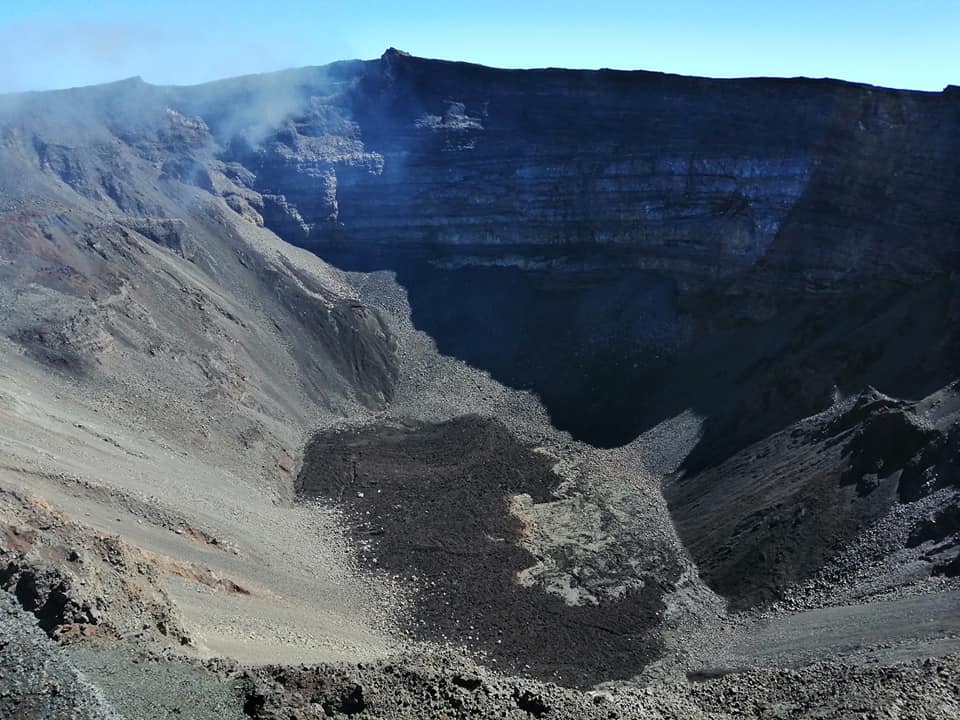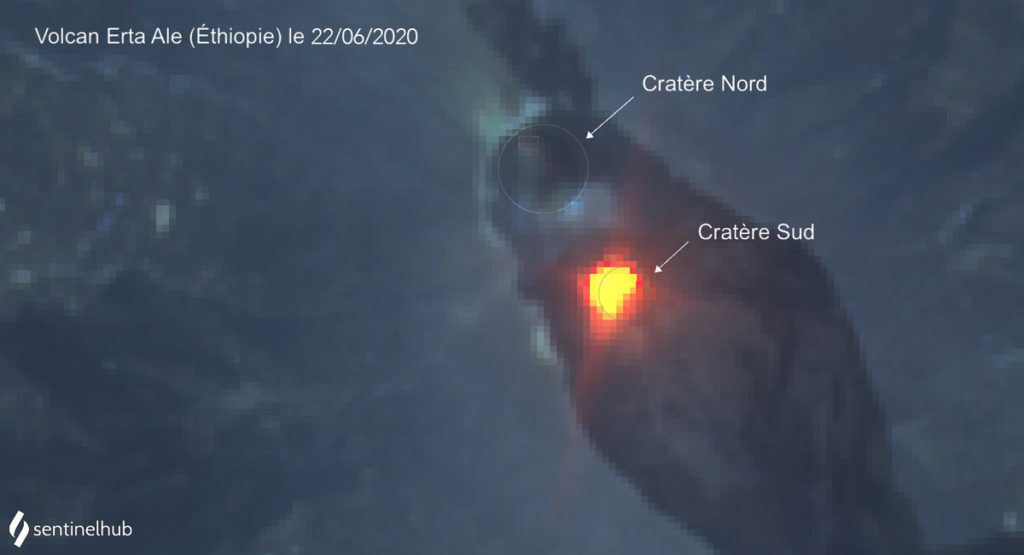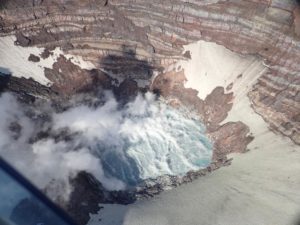September 24 , 2020 .
La Réunion , Piton de la Fournaise :
Activity bulletin for Wednesday September 23, 2020 at 11:15 a.m. (local time)
Recommended alert level: Vigilance
Since September 20, a resumption of seismicity has been observed under the Piton de la Fournaise. Thus between September 20 and 22, 21 earthquakes (Figure 1), of magnitude less than or equal to 1, were recorded and located under the Dolomieu crater between 1.7 and 2.2 km deep (Figure 2).
Figure 1: Histogram representing the number of superficial volcano-tectonic earthquakes recorded since September 1, 2020 (© OVPF-IPGP).
Figure 2: Location map (epicenters) and north-south and east-west sections (showing the location in depth, hypocenters) of the earthquakes recorded and located by the OVPF-IPGP between 20 and 22 September 2020 under the massif of Piton de la Fournaise. Only localizable earthquakes have been shown on the map (© OVPF-IPGP).
This seismicity is accompanied by a resumption of inflation (swelling) of the base and the top of the Piton de la Fournaise building. This building inflation remains very low for the moment and will have to be confirmed over time in the coming days.
This seismicity and deformation are synonymous with a pressurization of the superficial magmatic reservoir located about 2-2.5 km below the summit.
Soil CO2 fluxes also show a trend reversal since mid-August. After a long continuous phase of reduction of CO2 emissions in the soil following the last eruption (April 2-6, 2020), a new phase of increase has been observed since mid-August and has continued since. This increase in far-field CO2 is consistent with a deep rise in magma.
At the same time, the SO2 fluxes recorded in the air remain below the detection threshold. The concentrations of H2S and SO2 in the fumaroles in the summit area remain low and despite a slight tendency to increase the concentration of SO2 since August 2020, the concentrations are extremely low.
Note that this process of recharging the surface reservoir can last several days to several weeks before the roof of the reservoir weakens and breaks, thus giving rise to an injection of magma to the surface and an eruption, but can also stop without giving rise to an eruption in the short term.
Source : OVPF.
Read the article : http://www.ipgp.fr/fr/ovpf/bulletin-dactivite-mercredi-23-septembre-2020-a-11h15-heure-locale
Photo : Nath Duverlie
Colombia , Nevado del Ruiz :
Nevado del Ruiz volcano activity level bulletin.
The activity level continues at Yellow Activity Level or (III): changes in the behavior of volcanic activity.
Regarding the monitoring of the activity of the Nevado del Ruiz volcano, the COLOMBIAN GEOLOGICAL SERVICE reports that:
During the last week, according to the results obtained by monitoring the activity through the various parameters evaluated, the Nevado del Ruiz volcano continued to show instability in its behavior. An acceleration of the volcanic process and consequently changes in the level of activity of the volcano is not excluded.
Seismicity related to fluid dynamics inside the volcanic conduits had similar levels in the number of events and in the seismic energy released compared to the previous week. This seismic activity was characterized by the appearance of continuous volcanic tremor, tremor pulses, long and very long period type earthquakes, which presented variable energy levels and spectral content. Three confirmed ash shows stand out on September 15 and 20.
During the week, there was an episode of low-energy « drumbeat » type seismicity associated with the movement of fluids in the volcanic conduits. This seismicity has been linked to the processes of ascent, location-growth and evolution of the lava dome at the bottom of the Arenas crater.
The seismicity generated by the fracturing of the rocks showed a slight decrease in the number of earthquakes and the seismic energy released, compared to the previous week. This type of seismicity was mainly localized in the Arenas crater and in the North-East and South sectors of the volcano. The depth of the earthquakes varied between 0.4 and 7.9 km. The maximum magnitude recorded during the week was 0.2 ML (local magnitude) corresponding to the earthquake recorded on September 19 at 04:00 (local time), located 2.8 km northeast of the Arenas crater, at a depth 3.8 km.
The Nevado del Ruiz volcano continues at the yellow activity level
Source : SGC.
Photo : Auteur inconnu.
Ethiopia , Erta Ale :
13.6°N, 40.67°E
Elevation 613 m
Satellite data showed thermal anomalies in both of Erta Ale’s S and N pit craters in mid-August, though by 5 September only the N pit had anomalous temperatures.
Erta Ale is an isolated basaltic shield that is the most active volcano in Ethiopia. The broad, 50-km-wide edifice rises more than 600 m from below sea level in the barren Danakil depression. Erta Ale is the namesake and most prominent feature of the Erta Ale Range. The volcano contains a 0.7 x 1.6 km, elliptical summit crater housing steep-sided pit craters. Another larger 1.8 x 3.1 km wide depression elongated parallel to the trend of the Erta Ale range is located SE of the summit and is bounded by curvilinear fault scarps on the SE side.
Fresh-looking basaltic lava flows from these fissures have poured into the caldera and locally overflowed its rim. The summit caldera is renowned for one, or sometimes two long-term lava lakes that have been active since at least 1967, or possibly since 1906. Recent fissure eruptions have occurred on the N flank.
Source: GVP , Sentinel Hub.
Photo : Sylvie Vitton.
Chile , Nevados of Chillan :
36.868°S, 71.378°W
Elevation 3180 m
On 22 September SERNAGEOMIN reported that lava continued to advance down Nevados de Chillán’s NNE flank. Gas emissions and occasional explosions were also recorded. The Alert Level remained at Yellow, the second lowest level on a four-color scale, and residents were reminded not to approach the crater within 3 km. ONEMI stated that Alert Level Yellow (the middle level on a three-color scale) remained in place for the communities of Pinto and Coihueco, noting that as of 16 June the public should stay at least 3 km away from the crater on the SW flank and 5 km away on the NE flank.
The eruptive cycle of the Nevados de Chillán volcanic complex continues to evolve regularly, with the advance of the lava flow observed on the northern slope, added to the presence of the lava dome housed in the crater whose evolution begins to show signs of increased explosiveness, corroborated from satellite images.
Additionally, data from GNSS stations showed some minor variations, decreasing during this period. However, the recording of seismicity associated with the dynamics of fluids and explosions, thermal alerts, and recording of degassing and low height incandescence are consistent with the development of this type of surface magmatic body.
The current process is considered to be part of an intermittent eruptive dynamic with the emission of magmatic matter towards the surface and with a low level of explosiveness, it does not show signs which suggest for the moment a greater destabilization.
Source : GVP , Sernageomon , Segemar .
Photo : Josefauna.











